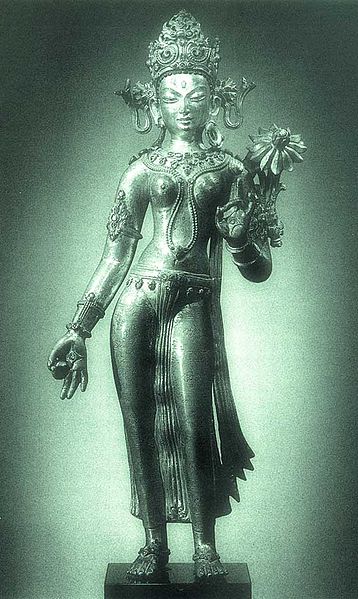Standing Bodhisattva Tara Images
The Mahayana traditions during the Buddhist period in Java were strongly influenced by Hindu and tantric teachings, so it seems that Tara was widely worshipped, as is the case in Tibet. However, reference examples of standing statues and figurines of Tara in Java are less common than Avalokitesvara. At this point the writer is inclined to consider images, which are distinctly female to be Tara otherwise to be Avalokitesvara. However, in some Tibetan stories she was described as a 16 year-old girl, which could, therefore, suggest less buxom representations. The other problem that arises is that Avolitesvara is often called the Bodhisattva Padmapani, which means holder of the lotus, but there are many examples of Tara with the padmapani posture. Thus this group of figurines include those, which are distinctly female and hold the lotus. The numbered images are part of the Apsarah Gallery Collection.
Nepalese Bodhisattva Tara
 Material: gilt copper.
Material: gilt copper.
Height: 514 mm.
Posture: tribhanga (three bends), with a lotus on the left shoulder, the left hand showing the vitarkamudra (teaching mudra) and the right hand holding a mani (jewel).
This is the Green Tara.
14thcentury, located at the the Metropolitan Museum of Art, New York.
Borobudur Bodhisattva Tara
 Material: andesite stone
Material: andesite stone
Patina: brownish green
Posture: tribhanga (three bends), with both hands showing padmapāṇi (holding lotuses).
1. Bodhisattva Tara
 Material: bronze
Material: bronze
Patina: brownish green
Posture: tribhanga (three bends), with the left hand showing the vitarkamudra (teaching mudra) and the right hand padmapāṇi (holding a lotus).
2. Bodhisattva Tara
 Material: bronze
Material: bronze
Patina: dark brown
Posture: tribhanga (three bends), with the right hand showing the vitarkamudra (teaching mudra) and the left hand padmapāṇi (holding a lotus).
3. Bodhisattva Tara
 Material: bronze
Material: bronze
Patina: brown
Posture: abhanga (standing on the left foot with the right leg bent at the knee) and the right hand showing the varadamudra (giving boons) and the left hand padmapāṇi (holding a lotus).
If not female the image may be the Bodhisattva Avalokitesvara.
Unusually fine detail and finish.
4. Bodhisattva Tara
 Material: bronze
Material: bronze
Patina: brownish green
Posture: sampada (standing with feet together), with the right hand showing the vitarkamudra (teaching mudra) and the left hand padmapāṇi (holding a lotus).
If not female the image may be the Bodhisattva Avalokitesvara.
5. Bodhisattva Tara
 Material: bronze, high relief.
Material: bronze, high relief.
Patina: dark greenish brown
Posture: samabhangha (standing upright with both legs bent), with the right hand showing the vitarkamudra (teaching mudra) and the left hand padmapāṇi (holding a lotus).
If not female the image may be the Bodhisattva Avalokitesvara.
Of the many manifestations of Tara in Tibetan Buddhism, the most often encountered are the White Tara and the Green Tara. The Tibetan script on the left is the White Tara mantra: Oṃ tāre tuttāre ture mama āyuḥ puṇya jñāna puṣṭiṃ kuru svāhā